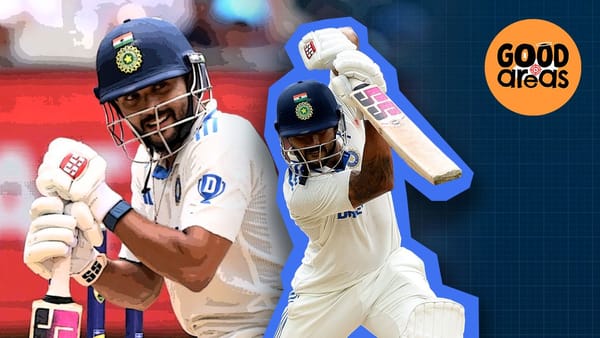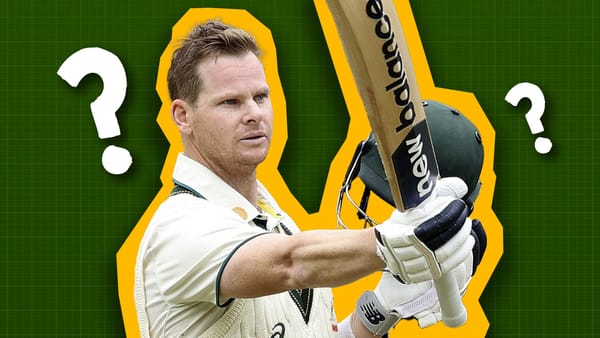Jonny Bairstow is perfect
The Test was close, then it wasn't.
Tom Latham made a mistake not putting nine men on the rope. And if that sounds like a ridiculous statement, then you didn’t see Jonny Bairstow bat.

But before that, England were going to chase 299 in 68 overs. That was a regular game of cricket thing to happen. And if there was anything we knew, they would go hard, because they promised it just as hard. It was weird how much England told New Zealand they’d chase anything regardless of the equation. Because that gave a big tactical advantage to New Zealand, but they never capitalised on it because of the two run outs and many other errors along the way.
But England also delivered on their promise. The first over has three fours. New Zealand knows Alex Lees is susceptible to cover driving, and they feed it to him, and he eats them. If New Zealand needs a reminder of how quick the outfield is, they got it fast.
But Trent Boult follows that up bowling two identical three-quarter seam wobbleballs pitching on and around leg stump that jag away. It was exactly how Zak Crawley was dismissed in the first innings, and it was how it happened in the second.
That was a great start, but the following over, Tim Southee struggled again. It was only five runs this time, but there was another poor ball that could have been punished and another so toothless that Lees was unlucky not to pierce the field. And that was it from Southee. He was yanked.
Do we get that move if Kane Williamson is in charge? Tom Latham is a little more proactive.
It’s the right idea, not just because Southee hadn’t got it right, but because there’s been a grass strip running down the pitch all game. Perhaps the curators put extra water on it because it got dry and maybe even cracked. That area is where most of the balls in this match misbehave.
While Southee could find it, Matt Henry would be better because he hits the wicket more as a seam bowler, and is just faster. Henry takes the glove of Ollie Pope and has another go under the bat. He’s looking good (especially after a terrible first innings), but you can’t help but wonder what Kyle Jamieson would do on this surface. It’s made for a strong, tall hit the wicket bowler. He’s off, watching with a sore back. And so Southee’s poor start, while recovered by Henry, still haunts New Zealand because of their lack of options.
While this is happening, Lees scores England’s first 30 runs. The first time that has ever happened in Test cricket. And England makes it to lunch only one wicket down, with over 10% of the chase wiped off and 10% of their wickets gone.
First ball after the break, they’re in trouble again as Pope edges another chance into the cordon. New Zealand are the best slip fielding team in the world, but they haven’t looked it this match, and Latham puts this chance down. Boult is by far the best bowler in this match, who gets the edge.
The over gets worse though as Boult fires down four byes. And that isn’t everything because umpire Gough is looking at the footmarks. It won’t be terminal and is not even on official warning. But if Boult can only bowl around the wicket, that’s an enormous blow to New Zealand with Jamieson’s injury and Southee’s early form.
Pope scores a couple of boundaries when Boult gets a bit wide. The problem on this pitch has always been the margin of error. If you aren’t exact with the ball, it almost certainly is a boundary.
Henry gets it right, a ball hits that strip, and instead of inconsistent bounce, it veers away to the slips and takes the edge. Now Joe Root is in the chase, and this feels like the chase.
So when he pushes back up the wicket to a Boult delivery that seems to grip in the surface for a caught and bowled, it feels massive. Root is gone, and New Zealand are so on top. I mean, it’s only Jonny Bairstow coming in, right?
It means they can even give Henry and Boult a quick rest, trying Bracewell against the left-handed Lees and going back to Southee. It’s clear that Southee has pulled his length way back, Cricviz say 37CM. He looks better, and as England looks to build a partnership, he takes the edge of Lees and they are now 93/4.
But something else happens when Southee bowls, Bairstow scores his second boundary. His first was a very conventional cover drive. This time he takes a quick shuffle down the wicket, changes the length and then drives the ball hard. Stokes also comes at Southee and pops him back over his head.
Double reverse sweeps for Stokes after Bracewell proves tough to get away. The first one was in the air, and directly over the head of backward point. So they kept the fielder up, and next ball Stokes does it again. It’s a clever over. Not only does it take two boundaries from Bracewell, but his first few overs had gone for only 10. You can’t allow the part-time spinner to slow you down.
England wants to take New Zealand on now, Lees tried. The other guys never got in, but Stokes and Bairstow are set. Bairstow pushing hard towards tea, and Stokes is too, but he looks in control. Bairstow looks like he’s right on the edge. He is ticking, but the runs aren’t coming as he wants. There is instability to his play. It feels like it could all be over quick.
As for the match, all four results are in play, including the chance of Jimmy Anderson having to nail a reverse sweep for a victory.
OK. That is analysis. It is an interesting game at this point. At one end there was some up and down bounce. At the other Southee and Boult were trying to find wickets and pressure. Bracewell worked early, and then England worked him over. Latham had been active. England were trying to land their counter punch.
This was all proper cricket, gripping, normal.What we have seen for generations with a couple of modern touches thrown in. After tea with 160 needed in 38 overs. It was winnable, no matter what result you thought was winning.
Then, a Bairstow bomb. Or bombs.
What was left of the game was charred and bloodstained. You could find chunks of it in the sponsored stand that looks like a dugout. If you want analysis, well at tea, England decided to hit more sixes, and New Zealand thought they’d go with the short ball.
These two ideas met each other like the randiest teenage lovers ruining the back seat of their parent’s car.
New Zealand tries some short pitch bowling, but without Wagner or Jamieson, it’s Henry who tries it. Wagner was on the field when Henry was bowling short theory. With Wagner’s field, but none of his venom or energy. It’s like watching Ringo Starr sing while John Lennon cleans the drums.
Henry doesn’t do it often, and in this case, he doesn’t do it well. Bairstow pulls two of them to the rope, then Henry goes too wide and Stokes lays one fine of deep point for another.
Why didn’t they go back to hitting the patch on the wicket where the ball was going up and down, is a question I would ask if I wasn’t counting the total runs of the over.
It doesn’t stop next over when Bairstow smashes Boult down the ground for another six. Before the ball has landed, Boult changes the field. The ball is hit straight, and Boult puts out a sweeper. The ball is behind him, he is pointing sideways. This is how New Zealand look.
Where is the wide outside off stump tactic and the seven two fields, someone probably thinks in the rare one-minute gap between boundaries.
It doesn’t stop next over as Henry gets heaved for another six, then four byes off Bairstow’s badge, and then another six. Bairstow is now head-butting fucken boundaries. Finally New Zealand stop the short ball tactic, but it’s already too late.
Why don’t they go for Yorkers and slower balls if quite clearly Bairstow has activated death T20 mode, is probably what the talk on the Kiwi balcony is.
It doesn’t stop next over with Boult delivering back of the length and Bairstow muscles it over deep midwicket. He pulls another one later in the over, and then finishes with a sliced four.
Why not bring Daryl Mitchell on as fresh chum so they can at least take the pace right off the ball, screams a New Zealand fan in a nightmare next week.
It doesn’t stop next over as Bairstow drives on the up through the offside. Then steers through the cordon. The only mercy is he seems to have cashed in his sixes to purchase some fours briefly.
Why not get Bracewell to come around the wicket and bowl into the back heel, suggests a 12-year-old watching a hologram of the game in the year 2036.
So many questions, so little time. This game exploded in front of them. There was no time. New Zealand were playing a Test, then suddenly they were trying to put the Hindenburg back together with things they found around the house.
It finally stops, or pauses, or at least slows a tad, because of England. And that’s because Stokes injures his knee. It means Stokes can’t get Bairstow on strike. New Zealand’s best chance is keeping Stokes on strike in a fourth-innings chase for a packed house in England. How has it come to this?
New Zealand almost runs out Stokes, who is so desperate to get his mate a 100 that he forgets he can’t run. That’s in a Bracewell over that is very well delivered for a part-timer. But still resembles the band playing as the Titanic sank.
There is a moment when Bairstow stops scoring as he looks for a safe option to make his hundred. Southee finds a suitable length for the second straight over, and the personal milestone makes Bairstow rethink slapping everything for six. But he can’t stop middling the ball; it’s like a mania. And he finds a gap on the offside and brings up his hundred.
Unshackled from the burden of self-gratification, Bairstow decides to end Bracewell. Sweep, six. Sweep, six. Sweep, four. Lucky they didn’t ask him to try bounce Bairstow.
Around this time, I write in my notes, “Tom Latham made a mistake not putting nine men on the rope.” I mean, they should have. Possibly putting every fielder - yes, Blundell, why not, fuck it - on the rope and allowed Stokes to come back on strike. Or at least, made it 30% harder for Bairstow to hit boundaries.
The World Test Championship holders' best chance of winning this Test was to try a method that really only exists in club competitions when a team of first-timers go up against a team with a ringer. To have any hope at all, New Zealand would have to give up on the pretence that they had any actual belief or plans to dismiss, or even slow Jonny Bairstow, and just chuck everyone on the rope.
It wouldn’t have mattered. Bairstow hit past them, through them and over them. The field wasn’t set, it was destroyed. These were not elite athletes representing their nation, but cardboard cut outs on a toy set that Jonny Bairstow set up in his bedroom.
And when he was finished with them, there was nothing left to play with. Jonny Bairstow destroyed the cricket nation formerly known as New Zealand. Sweep up the pieces you can find, put them in a jar, stick a label on it, and send them to Headingley. Where Jonny Bairstow is from.
New Zealand made mistakes, but Jonny Bairtsow was perfect.




